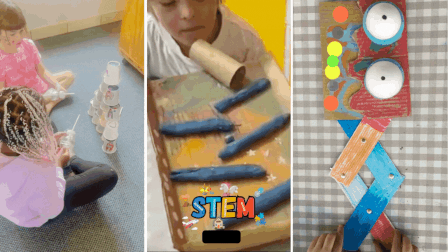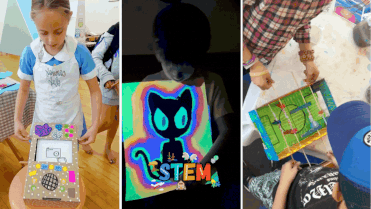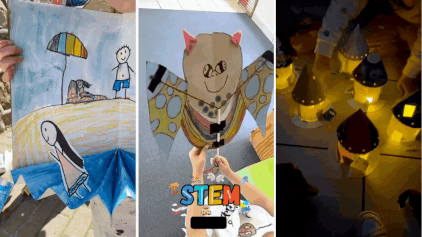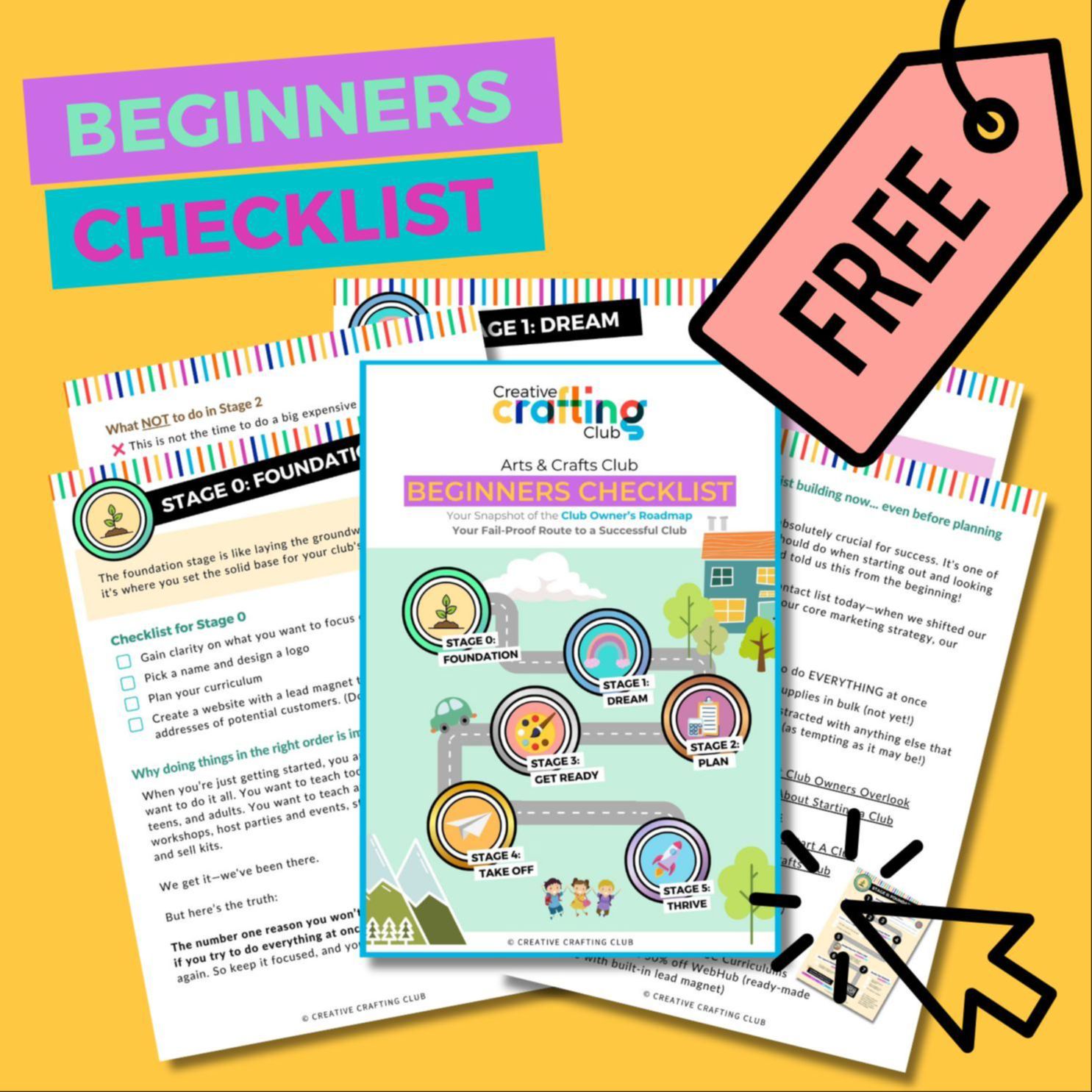What Parents Are Begging For (And Only STEM Crafting Delivers)
Posted on Aug 27, 2025Remember when crafting with kids meant making cute decorations for the fridge? Those days are over.
Today's parents aren't just looking for activities to keep their children busy. They're desperately seeking experiences that prepare their kids for a future that looks nothing like the world we grew up in.
Here's the reality: 85% of jobs that will exist in 2035 haven't even been invented yet.
STEM (Science, Technology, Engineering, and Math) occupations are growing twice as fast as other fields. And the children in your craft club today will be entering a workforce dominated by artificial intelligence, robotics, and technologies we can barely imagine.

Incorporating STEM into your classes will set you apart AND set you and your students up for future success.
We know what you're thinking. STEM sounds complicated. But we're here to tell you that adding STEM crafts to your club doesn’t have to be daunting. In fact, it’s easy to do, and we’re going to show you how!
What Kids Are Really Dreaming About
We recently asked children about their dream careers. Here's what we heard:
- "I want to be an inventor and make YouTube videos" (Gianluca, 6)
- "I want to work in artificial intelligence" (Oliver, 7)
- “I want to design video games” (Sarah, 8)
These aren't the career aspirations of previous generations. Today's kids are already thinking like innovators, entrepreneurs, and problem-solvers. They're imagining careers that don't even exist yet.
As craft club leaders, we have an incredible opportunity to nurture this natural curiosity and channel it into skills that will serve them for life.

Why STEM-Crafting Is Your Secret Weapon
While other craft clubs are still focused on "cute projects", you can position yourself as the leader who develops future innovators. Here's why STEM-crafting gives you a massive competitive advantage:
⭐️ Parents Are Actively Seeking STEM Education
Parents understand that traditional "fridge art" crafts aren't enough anymore. They want activities that will prepare kids for the future, hands-on experiences that teach valuable skills not often offered in schools, and that keep them engaged away from screens.
When you position your craft club as STEM education, you directly address parents’ top priority: setting their child up for long-term success.
⭐️ Kids Learn Best Through Hands-On Discovery
STEM crafting perfectly combines the natural way children learn (through play and exploration) with the critical thinking skills they'll need tomorrow.
When kids build a marble run, they're having fun AND they're learning physics, engineering principles, and problem-solving strategies.
⭐️ You Don't Need to Be a Scientist or Engineer
The beauty of STEM crafting is that it happens naturally when kids explore, experiment, and create. Luckily you don't need to have a science or engineering degree to facilitate this learning. You just need to guide their natural curiosity in the right direction.
Click further down below to grab a free lesson plan and see just how simple it can be when you follow an easy, step-by-step process.
The 3 Pillars of Successful STEM-Crafting
1. Nurture Curiosity Through Questions
Instead of giving instructions, become a question-asking facilitator. Transform your teaching approach:
Instead of: "That's wrong, let me fix it."
Try: "Interesting! What do you think made it work that way?"
Instead of: "Follow these steps exactly."
Try: "What are some different ways we could approach this?"
The goal is to inspire kids to think like inventors, not just follow directions.
2. Embrace the Mess (They're Learning!)
Learning through experimentation gets messy, and that's exactly the point. When kids splash paint, take things apart, or bend materials until they break, they're conducting experiments.
As engineers say, "We don't fail, we collect data." Every "mistake" in your craft club is actually a learning opportunity that brings kids closer to innovation.
Let go of the need for perfect outcomes and embrace the beautiful chaos of discovery.
Add one line on how you can educate parents to understand that they should not expect a “perfect” piece of art each week; that's not what it's about. So often, club owners think that this is what parents expect.
3. Celebrate the Process, Not Just the Product
Innovation happens through iteration. Show kids that the journey of trial, error, and improvement is just as valuable as the final result.
Create an "oops folder” on your phone, or an “oops table". This allows kids to showcase their experiments that didn't work as expected and what they learned from each attempt. This builds resilience and teaches them that success comes through persistence.

3 STEM Activities That Will Transform Your Craft Club (FREE Downloads!)
1. Radical Marble Run Using Recycled Materials
Parent Appeal: "My child is learning engineering and physics through play!"
Skills Developed: Executive function, critical thinking, problem-solving, spatial reasoning
Materials: Recycled cardboard box, paper rolls, marbles, playdough, stapler, decorating supplies
STEM Elements: Engineering (structural design), Physics (gravity, motion), Math (angles, trajectories)
Kids create their own marble run using recycled materials, learning about gravity, angles, and problem-solving as they design different paths for their marbles.
They use playdough to create walls and can modify their design until it works perfectly, teaching them that failure is just "data collection" on the path to success.
2. Magnetic Race Track Using Recycled Materials
Parent Appeal: "My child is learning about magnetism and physics while creating a SUPER FUN game!"
Skills Developed: Executive function, critical thinking, problem-solving, spatial reasoning, fine motor skills
Materials: Recycled cardboard, string, magnets, metal keyrings, cork, markers, watercolors, masking tape, recycled paper rolls
STEM Elements: Physics (magnetism, forces), Engineering (design, testing), Math (geometry, measurement)
Kids design and trace a race track using string as a guide, then create magnetic cars using keyrings and magnets attached to corks.
They learn about magnetic attraction while testing their cars and decorating the track collaboratively with family members using a spinner game.
This activity teaches them that magnetic forces work through materials and at a distance, turning physics concepts into an engaging family game experience.
3. Erupting Volcano Using Household Materials
Parent Appeal: "My child is learning about chemical reactions and geography through explosive fun!"
Skills Developed: Executive function, critical thinking, problem-solving, observation skills, scientific method
Materials: Baking soda (bicarbonate of soda), liquid soap, vinegar, a silver tray, small bottle, clay or playdough, a toilet roll, measuring spoons
STEM Elements: Chemistry (acid-base reactions), Geography (volcanoes, Earth science), Math (measurement, ratios), Physics (pressure, gas formation)
Kids build a volcano model around a bottle using clay or playdough, then create a chemical eruption by mixing baking soda, soap, and vinegar inside. They learn about acid-base reactions as the mixture foams and bubbles over, simulating real volcanic eruptions.
This activity teaches basic chemistry principles while connecting to geography lessons about how volcanoes form and erupt. This makes abstract scientific concepts tangible and exciting through hands-on experimentation.
How to Structure Your STEM Classes for Maximum Impact
Follow this proven 5-step process:
- Problem Introduction: "Today we're going to solve the challenge of..."
- Brainstorming: "What are some ways we could..."
- Building/Creating: Hands-on construction time
- Testing: "Let's see if our solution works..."
- Reflecting: "What would we change next time?"
And as facilitator, don’t forget to; Celebrate The Effort
STEM is about trying, failing, and improving. Building in a moment to share their efforts, highlight—whether it worked or not—teaches resilience and makes kids proud of the process, not just the result.
This structure teaches kids to approach problems like real engineers and inventors.

Marketing Messages That Fill Your Classes
For Your Website: "We don’t make decorations, we build future innovators. Our STEM approach develops critical thinking, problem-solving, and resilience through hands-on creative challenges."
For Social Media: "Watch 7-year-old Emma explain how she engineered moving parts for her puppet show! This is what learning looks like when kids think like inventors. #STEMEducation #FutureReady"
For Parent Conversations: "Our classes prepare kids for careers that don't even exist yet. Through creative crafting, they’ll develop the same skills that drive innovation at companies like Google and Tesla."
This flyer has helped us fill our classes every time ⬇️. Doesn’t it make you want to sign your child up, too?

P.S. If you’re a CCC Academy member, you can grab the editable version of this flyer in your ‘Resources’ section.
Why Now Is the Perfect Time to Make the Switch
The craft club owners who embrace STEM education today will dominate their markets tomorrow. Parents are no longer just looking for fun activities. They want programs that help their children build real-world skills and stay ahead. Craft clubs that include STEM learning are meeting this need in a way traditional clubs can't.
When you position yourself as the STEM expert in your community, you become the go-to choice for families who care about both creativity and education. You're offering something valuable, relevant, and in demand. And that's what will keep your classes full.

Your Next Steps
- Choose a STEM activity from the list above to try in your next class
- Update your marketing materials to emphasize skill development over cute crafts
- Start tracking parent responses to your new positioning
Ready to transform your craft club into a STEM powerhouse? The children in your community are counting on you to prepare them for a future full of incredible possibilities. Don't let them down.
The time to act is now. The future is waiting.
Ready to Get Started With Your STEM Crafting Club?
Get our Beginners Checklist to discover what it really takes to start your own successful STEM crafting club for kids.
Christelle & Stefanie
Founders, Creative Crafting Club







